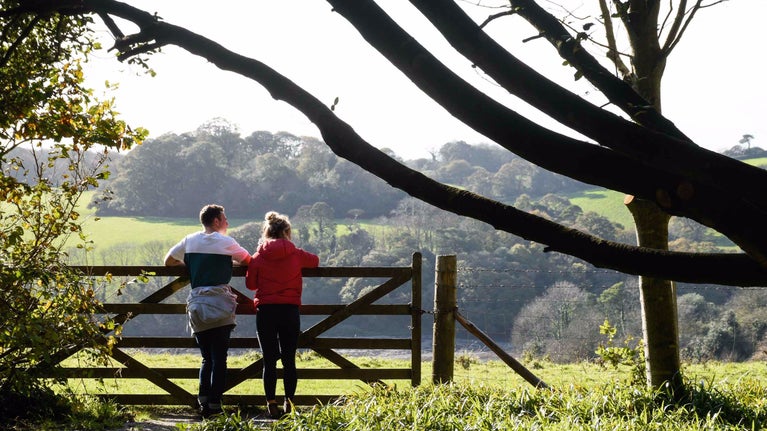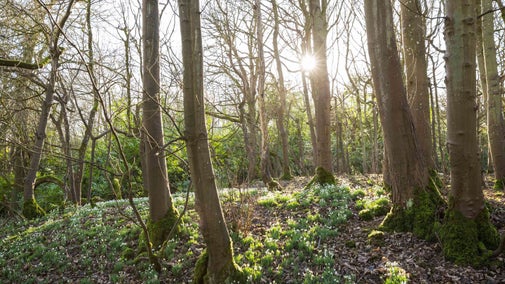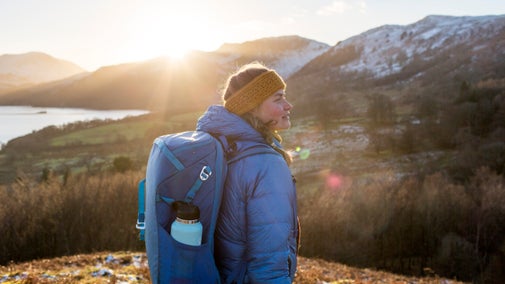
Trelissick's collections
Explore the objects and works of art we care for at Trelissick on the National Trust Collections website.

The wider estate at Trelissick has over 300 acres of diverse countryside. You can take in the maritime views, stroll through panoramic parkland or venture out into secluded oak woodlands.
Following extensive damage to the estate and garden caused by Storm Goretti, Trelissick will be closed until further notice.
The parkland is the gateway to Trelissick's countryside with far reaching views down the Fal River. During the winter areas of grass may be roped off at times to limit damage and allow for the ground to recover during this wetter period.
At high tide this is the perfect spot to take in the incredible surroundings. Looking downriver the water at your feet stretches miles to the town of Falmouth past picturesque harbours and wooded banks.
With the countryside managed to reduce soil and nutrient run off, the local wildlife enjoys a high level of water quality.
Trelissick is known as much for its wildlife as it is for its history and natural beauty. In the woodland, dead trees stand amongst the living and are home to a number of insects, animals and birds living in and around the estate.
Two picturesque paths (north and south woodland walks) thread their way through the trees and both are suitable for families, ramblers, joggers and dogs. From these trails, glimpse the curves and contours of the river through the leaves of twisted oaks that grow right down to the water's edge.

Follow the north woodland walk over the timber bridge to Roundwood and Tregew, and travel back through thousands of years of Cornish history to the very impressive Iron Age promontory fort and eighteenth century quay.
The fort is the only one of its kind in Europe and its well-defined ditches and embankments are still clearly visible.
During the spring and summer months, it is always a stunning time of year to get outside. Take in the surroundings of the nature and wildlife of an ever evolving land and seascape and the scenic estuary views across the River Fal.
As summer turns to autumn see the leaves change colour and the ground getting covered, which allows all the light in through the trees. Keep an eye out for birds and other wildflife as you walk through the woodlands and parklands. How many have you seen? Which ones did you see? Autumn is a great time for nature watching and to be reinspired by the natural world.
Make sure to spend some time on the beach, where you can try skimming stones and bravely have a paddle in the water.
Then finish off with a refreshing drink or ice cream at the café, or visit the gift shop and plant centre for a special memento of your day.

Wildlife is abundant across the Trelissick estate. With such a wide variety there are some special insects, animals and birds to look out for during your visit.
Tregew, like the rest of the farmed estate, is managed specifically for its wildlife. It is a haven for once common, but now rare species such as harvest mice, skylarks, barn owls and a huge number of grassland insects. These paths and fields overlook Cowlands Creek, traditionally associated with oyster fisherman and the lovely Kea plum orchards.
Winter is normally a time when food is scarce, and our native wildlife is laying low. Some creatures are hibernating waiting out the cold until spring rolls back around. For many animals however, these darker days are when they are most active.
Leaves fall from the trees, hedgerows become sparse and frosty mornings betray tracks and spiderwebs, all allowing previously elusive creatures to become more visible.
One of the Nation’s favourite birds. Is there a bird more emblematic of the festive season than a robin?
Robin redbreast is vocal, precocious and injects an often much-needed splash of colour into the dreary days of winter. Robins are also sedentary, meaning they do not migrate but defend their territories year-round and so are often easy to spot in the sparse, winter woodland or even more so as they loudly demand pasty crumbs and sandwich ends.
If we have a mild winter, Robins can begin to breed as early as January and in more usual circumstances they will certainly have begun by March.
Unusually, both these birds begin their courtship in winter and there is a good chance of hearing them as they are at their noisiest during the cold season.
If you can hear an owl, you might be surprised to learn that the famous ‘tuwhit-tuwhoo’ sound is most probably being made by two birds. This is because, although both sexes can make the ‘tuwhit’ sound, only the males can call out ‘tuwhoo’, so the famous owl call is often a male responding to a female. Owls mate for life but repeatedly consolidate their bond through courtship, feeding and communication. Tawny Owls are believed to be most vocal from December through to February so listen out for them on your walk.
During January and February, the woods can often reverberate to the drumming of the Greater Spotted Woodpecker. These wonderful birds can strike their sharp beaks as many as 40 times per second. Drumming is usually the way a woodpecker finds its food, seeking out grubs that live in decaying wood but during the winter it also doubles up as a way of attracting a mate. Males will drum up to 600 times a day until they have found a partner, so these early months of the year are a great time to try and locate them.
Frosty, winter mornings are the perfect time to go out looking for spider webs. When the dew settles upon a spider’s silk these beautiful constructions suddenly become far more visible and you realise just how many there are!
Why not go out for an earlier walk around the Estate and spot webs in hedgerows, fields, high up in trees or in the windows of buildings?
Spider silk is an amazing substance and – if you are lucky – you might even catch a spider making its web, so then you can see how expertly they are constructed.
Cattle graze in the parkland for some months of the year in order to maintain the habitat, please observe signage at the entrance to the parkland. Please ensure dogs are kept on leads when livestock are present. If cattle approach you, it's best to let your dog off the lead, and call them back when it's safe to do so.

Explore the objects and works of art we care for at Trelissick on the National Trust Collections website.
Discover the history of Trelissick house and estate, what makes it special and the people who lived here.

Discover the dog-friendly estate at Trelissick, with parkland, woodland, winding garden paths, shoreline and beach to explore. Trelissick is a two pawprint rated place.

Find out where to buy food and drink, and browse for gifts and souvenirs, during your visit to Trelissick.

Plan a visit to one of the special countryside places in our care and discover the benefits of being in the great outdoors. Pack your walking boots and get ready to explore woodlands, valleys and rivers.

Explore some of the finest landscapes in our care on coastal paths, accessible trails, woodland walks and everything in between. Find the best places to walk near you.

Cornwall has a wealth of woodlands, bridleways, trails and paths to explore including a wet willow woodland. Experience fresh air outdoors with the whole family this summer and look out for an abundance of wildlife and butterflies that call this place home.
